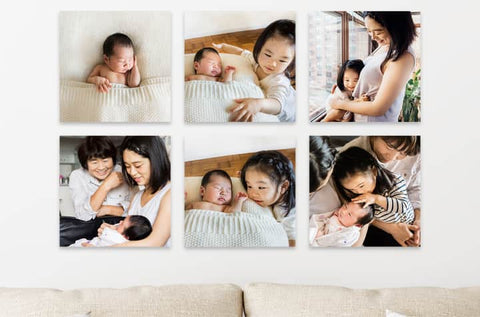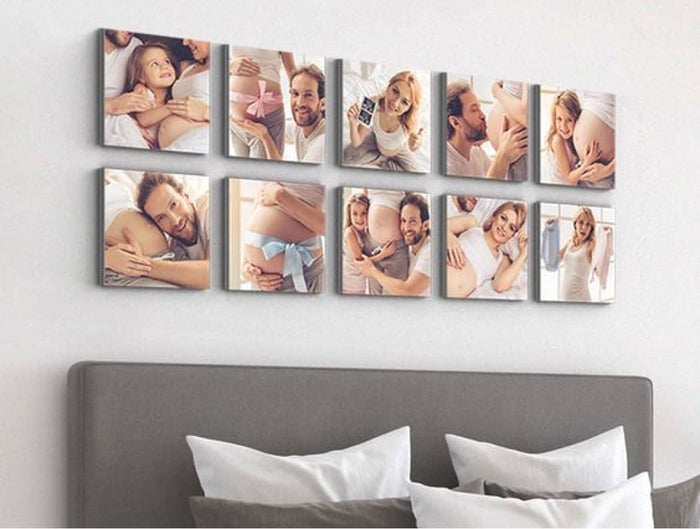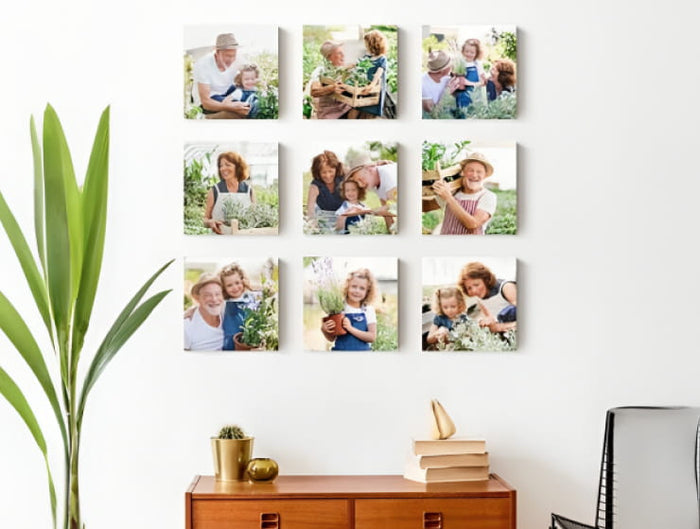Framed Wall Pictures & Art: Top Sources for Your Living Room
When you step into a thoughtfully decorated living room, one of the first things that catches your attention is often the wall art. Among the many forms of wall decor, framed wall pictures stand out because they offer a timeless balance of style, sentiment, and sophistication. A framed wall picture can transform an empty wall into a storytelling surface, capturing emotions, memories, or pure artistry that resonates with the household. But what exactly are framed wall pictures? At their essence, they are photographs, posters, or artworks placed within a frame for protection, durability, and presentation. Unlike unframed prints, a frame adds structural stability and a finished look, allowing the piece to harmonize with the surrounding décor. Frames themselves come in a wide variety of materials such as wood, metal, glass, or even modern composites that give homeowners ample choice to match their interior theme.
Framed wall pictures are not only about preservation but also about enhancing the viewing experience. A wedding photo in a plain print may be beautiful on its own, but when placed in a sleek black or white frame, it takes on a gallery-like quality. Similarly, travel photographs framed in rustic wooden borders can evoke a sense of nostalgia and warmth, making the living room feel more personal and inviting. For many households, framed wall pictures serve as a bridge between private memory and public display, allowing cherished experiences to become a part of everyday life while enhancing the aesthetics of the space.
The concept also extends to art lovers who prefer illustrations, abstract paintings, or digital artwork. A framed art piece is more than decoration; it is an anchor that sets the mood of the room. For example, a minimalist monochrome sketch framed in simple white can bring calm and serenity, while a bold c,,olorful painting in a golden frame can energize the room and draw attention. Essentially, framed wall pictures work as both décor and self-expression, enabling people to define their style through carefully curated visuals.
Another important dimension of framed wall pictures lies in customization. With modern printing technology, individuals are no longer limited to purchasing pre-made posters or artwork. They can now turn their personal photos into high-quality framed prints, perfectly suited for their living rooms. This democratization of art and photography has made framed wall pictures accessible to a wide range of people, whether they are passionate photographers, parents capturing family moments, or homeowners seeking stylish décor solutions.
In essence, framed wall pictures embody a union of function and beauty. They protect cherished prints while simultaneously elevating them into statement pieces that complement the room. When placed strategically in a living room, they can set the tone for the entire household—whether it is cozy and welcoming, bold and modern, or refined and elegant. To truly understand why they are so impactful, it helps to explore not only what they are but also the role they play in shaping identity and atmosphere within a home.
Why Framed Wall Pictures Hold Value in Living Room Décor
The living room is often considered the heart of a home. It is where families gather, where guests are welcomed, and where moments of relaxation take place. Because of this, the design of a living room deserves special attention. Furniture, lighting, and color palettes all play a role, but the walls often hold the most potential for personal expression. Bare walls can leave a space feeling incomplete, while well-chosen framed wall pictures can bring depth, texture, and emotion.
One of the key reasons framed wall pictures hold value is their ability to bring personality into the living room. Every household has its own story, and framed pictures allow that story to be told visually. A series of black-and-white family portraits can create an intimate gallery wall, while landscape photography from travels can inspire wanderlust and conversations. Art prints, on the other hand, can convey the taste and style of the homeowner, showing their preference for classic, modern, or experimental aesthetics.
Another reason is the sense of order and structure that frames provide. Loose posters or unmounted prints may appear casual or temporary, but framed pictures create a sense of permanence. They signal intentional design rather than improvisation. The clean lines of a frame act as boundaries, guiding the viewer’s attention to the artwork or photo inside while also tying the piece into the surrounding décor. In modern design theory, framed wall pictures are often described as focal points that balance the elements of a room.
The value also extends to emotional impact. A living room decorated with framed wall pictures does not just look beautiful—it feels alive. Imagine walking into a room where a large framed canvas of a wedding day takes center stage. The picture evokes not only memories but also emotions of love and unity. Similarly, framed photos of children, pets, or milestones create a living archive that keeps the essence of family close at heart. This emotional resonance makes framed wall pictures more than just objects—they become vessels of memory and meaning.
From a practical standpoint, framed wall pictures also provide durability and protection. A frame shields the print from dust, scratches, and bending, while a glass or acrylic cover can prevent fading from exposure to light. This means that cherished memories and artworks can be preserved for years without losing their quality. Homeowners no longer need to worry about replacing damaged or worn prints because framed options maintain their integrity over time.
Finally, framed wall pictures can transform the overall mood of a living room. Dark wooden frames combined with sepia-toned prints can create a vintage or rustic feel. Metallic frames paired with abstract art can give a modern, urban vibe. Large panoramic prints in minimalist frames can add grandeur and openness to a small room. The adaptability of framed wall pictures makes them suitable for all design styles, from Scandinavian minimalism to traditional elegance.
In short, framed wall pictures bring together aesthetics, memory, protection, and personalization. They enrich living room spaces in ways that go beyond mere decoration, helping to build an environment that feels lived-in, expressive, and uniquely tied to the household’s identity.
The Evolution of Framed Wall Pictures as a Design Element
Framed wall pictures are not a new concept; they have been part of interior decoration for centuries. What has changed is the accessibility, materials, and customization possibilities available today. In earlier times, framed pictures were often reserved for wealthy households or public institutions. Paintings and portraits commissioned by aristocrats were framed in elaborate, ornate wood carvings that signaled status and prestige. Over time, photography introduced a new wave of framed images, allowing more families to capture and display moments of personal significance.
By the mid-20th century, framed wall pictures became common household items. Families displayed graduation photos, wedding portraits, and holiday memories in modest frames that aligned with their budgets. The democratization of printing and framing allowed everyday households to access what was once considered luxury décor. With the advent of digital photography and online printing, this trend expanded further. Now, anyone can upload a photo from their phone, select a frame, and receive a ready-to-hang picture delivered to their doorstep.
This evolution also reflects broader cultural shifts in how people relate to art and memory. In the past, walls were often decorated with traditional oil paintings or religious imagery. Today, walls can feature anything from abstract digital art to playful travel snapshots. The meaning of framed wall pictures has expanded from mere decoration to personal storytelling. They no longer serve just to impress visitors but to create living environments that resonate with the inhabitants themselves.
Modern design trends have further elevated the role of framed wall pictures. Minimalist interiors often use a few carefully chosen framed prints to add subtle character without clutter. Contemporary bohemian styles might embrace eclectic gallery walls with mismatched frames and diverse artwork. Meanwhile, luxury interiors often employ oversized framed art pieces as dramatic focal points. Across these trends, one thing remains constant: framed wall pictures continue to adapt, proving their timeless relevance.
What makes this design element particularly appealing today is its versatility. Homeowners and renters alike can personalize their space without major renovations. A simple framed photo arrangement can dramatically alter the feel of a living room without requiring new furniture or paint. This adaptability makes framed wall pictures one of the most cost-effective yet impactful ways to refresh an interior.
How Framed Wall Pictures Influence Atmosphere and Lifestyle
Beyond aesthetics, framed wall pictures also influence how people feel within their homes. Psychology plays a significant role in interior design, and visual elements like framed pictures have been shown to affect mood and atmosphere. For example, family portraits create a sense of belonging and comfort, while nature photography can reduce stress and evoke calmness. Abstract art with vibrant colors may energize a space, stimulating creativity and conversation.
The choice of frames also contributes to the atmosphere. Light-colored wooden frames can make a room feel airy and organic, while sleek black or metallic frames add modernity and sophistication. A combination of multiple frames arranged in a gallery wall can create dynamism and visual rhythm, making the living room feel active and engaging. On the other hand, a single oversized framed print can evoke tranquility and focus, giving the room a clear centerpiece.
Lifestyle preferences are often reflected in the choice of framed wall pictures. Travel enthusiasts may display panoramic shots from their journeys, turning their living room into a map of adventures. Parents may prioritize displaying milestones such as birthdays, graduations, or family portraits, turning the space into a living album. Art collectors might showcase reproductions or original works, highlighting their appreciation for culture and creativity. In each case, framed wall pictures act as mirrors of the inhabitants’ lives and values.
Moreover, framed wall pictures encourage mindfulness. In a fast-paced world dominated by digital devices, pausing to look at a cherished photo on the wall provides grounding. It reconnects people with memories, values, and aspirations. This is why many modern households consider framed wall pictures essential rather than optional. They bring emotional richness that no digital slideshow or phone gallery can replicate.
From atmosphere to lifestyle, the impact of framed wall pictures goes far beyond decoration. They transform spaces into meaningful environments that resonate with personality, history, and dreams. This explains why they continue to be one of the most popular and enduring elements in living room décor.
The Timeless Appeal of Framed Wall Art
Framed wall pictures carry a charm that never goes out of style. Unlike temporary décor pieces that follow seasonal fads, framed artwork has been used for centuries to adorn homes, palaces, and cultural spaces. This longevity speaks to their enduring appeal. When you bring framed wall art into your living room, you are not simply hanging an image on a wall; you are participating in a tradition that has enriched interiors for generations.
The frame itself elevates the image, turning a simple print into a piece that feels curated. The act of framing implies permanence, suggesting that the image inside is worth preserving and showcasing. Whether the subject is a treasured photograph, a family portrait, or a fine art print, the addition of a frame signals importance and respect for the visual content. This gives the living room an aura of thoughtfulness and refinement that would be hard to achieve with unframed décor.
In many homes, framed wall art also works as an anchor of stability. The crisp lines of the frame bring structure to the image and create a balanced composition within the room. Even when the picture inside is bold, colorful, or abstract, the frame provides boundaries that make it feel organized. This interplay between structure and expression is what makes framed wall pictures so universally effective across different interior styles.
Expression of Personality and Taste
Your living room is often the most public area of your home, where family members gather and guests spend time. The art and pictures you choose to display there become a reflection of who you are. Framed wall pictures provide a direct opportunity to express personality and taste in a visible and elegant way.
For example, a minimalist household may opt for clean black frames with monochrome photography, creating a sleek and modern look. In contrast, a family that values warmth and tradition may choose wooden frames paired with nostalgic family portraits. Art enthusiasts might fill their walls with framed reproductions of famous paintings or contemporary abstract pieces. Each decision tells a story about values, passions, and aesthetics.
Framed wall pictures also allow for experimentation without risk. Unlike permanent changes such as wall paint or built-in furniture, framed pictures can be rearranged, replaced, or updated as tastes evolve. This flexibility means you can continuously refresh the living room to reflect changing moods or phases in life. A series of framed photographs from recent travels, for example, can later be replaced by portraits or artwork as the household’s priorities shift.
In essence, framed wall pictures allow the living room to become a living, breathing canvas that grows with the people who inhabit it. They provide a personal stamp that transforms the space from a generic room into a home full of identity and meaning.
Creating Atmosphere and Emotional Connection
Every interior space has a mood, and framed wall pictures play a powerful role in shaping it. The choice of imagery, colors, and frame styles all work together to influence how the living room feels to those who spend time there.
A living room decorated with framed family portraits creates warmth and intimacy. The presence of familiar faces evokes comfort and belonging, making the space more inviting. Travel photography displayed in elegant frames can transport viewers back to memorable destinations, filling the room with a sense of adventure and discovery. Similarly, nature-inspired framed prints can bring tranquility and calmness, ideal for a space meant for relaxation.
The emotional connection framed wall pictures create cannot be underestimated. When you glance at a framed photo of a milestone event—such as a wedding, a graduation, or the first steps of a child—you relive that moment for a brief second. These reminders become part of everyday life, reinforcing joy and gratitude. The frame ensures that the memory is not just stored away but integrated into the household’s shared environment.
Even when the imagery is not personal, framed art still contributes to the atmosphere. Abstract art in vibrant colors can energize a room and spark conversation. Landscapes can bring openness and serenity. Black-and-white photography can introduce sophistication and depth. No matter the choice, framed wall pictures help to set the emotional tone, making the living room more than just a physical space.
Practical Benefits of Framed Pictures
While the aesthetic and emotional value of framed wall pictures is clear, they also offer practical advantages. Frames protect images from damage, ensuring longevity. The glass or acrylic cover shields prints from dust, scratches, and fading caused by light exposure. Without this protection, prints can deteriorate quickly, losing both vibrancy and detail. A frame extends the lifespan of the artwork, allowing it to be enjoyed for years without loss of quality.
Another practical benefit is versatility. Frames come in countless styles, sizes, and materials, making it easy to find options that fit different interior themes. A slim black frame works well in modern and industrial settings, while ornate carved wood fits traditional or vintage-inspired interiors. Floating frames can give a contemporary edge, while metal frames add sleekness. This versatility means that no matter what your living room looks like, there is always a framed option that will integrate seamlessly.
Framed pictures are also easy to maintain. Cleaning a framed print typically requires no more than a soft cloth for the glass or acrylic surface. Unlike open canvases or textured décor items, framed pictures do not easily collect dust or grime. This low-maintenance quality makes them particularly practical for busy households.
Lastly, framed pictures are an adaptable design element. They can be hung individually as statement pieces or grouped to create gallery walls. This adaptability makes them suitable for both small apartments and large houses, as they can scale according to the available wall space.
The Impact of Framed Wall Pictures on Modern Homes
Modern lifestyles have brought significant changes to how people design their living spaces. Many contemporary homes favor minimalism, functionality, and open layouts. Within such interiors, framed wall pictures have become essential because they introduce personality without disrupting clean lines. A carefully chosen framed print can add depth and individuality to a minimalist space, breaking monotony without creating clutter.
In homes where technology dominates daily life, framed wall pictures also provide a grounding influence. Screens, devices, and digital content often occupy attention, but framed prints bring focus back to the physical world. They remind people of tangible memories, experiences, and creative expression that go beyond digital scrolling. This grounding effect contributes to a more balanced and thoughtful living environment.
Another modern trend is the preference for customization. Homeowners increasingly seek décor that feels unique and personal rather than mass-produced. Framed wall pictures fit perfectly into this desire because they can be customized to display personal photos or chosen artworks that resonate on an individual level. Unlike generic store-bought decorations, framed prints carry distinct meaning, giving modern homes a sense of authenticity.
Moreover, framed wall pictures align with sustainability and conscious living. By selecting durable frames and high-quality prints, homeowners invest in décor that will last rather than disposable items that quickly lose relevance. This approach not only supports environmental responsibility but also promotes a mindset of valuing quality over quantity.
Why They Are an Investment in Lifestyle
When viewed holistically, framed wall pictures are more than decorative objects. They are investments in lifestyle, wellbeing, and identity. A home without wall art may feel functional but incomplete, whereas framed pictures bring coherence and emotional depth. They provide daily reminders of values, memories, and aspirations, enriching the quality of life within the household.
The investment is not necessarily financial, although framed prints often hold their value through durability. More importantly, it is an emotional investment. The effort to select, frame, and display pictures reflects care for one’s surroundings. This care translates into a sense of pride and satisfaction when stepping into the living room each day. Guests notice it too, often commenting on the beauty or significance of the displayed images.
In this way, framed wall pictures create a cycle of positivity. They enhance aesthetics, strengthen emotional bonds, protect cherished images, and offer long-lasting style. These combined benefits make them one of the smartest décor decisions for any living room.
The Art of Selecting the Right Images
The journey of decorating a living room with framed wall pictures begins with the choice of imagery. Selecting the right image is about more than aesthetic appeal; it is about creating harmony between personal meaning and design style. The images chosen will likely become focal points in the room, which means they should reflect the spirit of the household.
Family portraits are an obvious choice for many homes, but beyond portraits, there are countless options. Landscape photography brings elements of nature indoors, connecting the home to a broader sense of beauty and calm. Abstract art, with its bold colors and unique shapes, adds dynamism and energy. Minimalist sketches, black and white photography, or cultural artworks can bring sophistication and cultural depth.
The theme of the living room often helps narrow down the choices. For example, a coastal-themed home might benefit from framed images of beaches, waves, or marine life. An urban loft could use cityscape photography or modern geometric prints. A countryside cottage might lean towards rustic landscapes, vintage illustrations, or botanical drawings. By aligning images with the larger theme of the space, homeowners ensure visual consistency and atmosphere.
It is also important to consider emotional resonance. A framed picture is not just an object—it is a constant presence in daily life. Choosing images that evoke joy, calmness, inspiration, or nostalgia ensures that the framed wall pictures contribute to the overall emotional tone of the home.
Understanding the Role of Size and Scale
Size is a critical factor when selecting framed wall pictures for the living room. Too small, and the piece may look insignificant against a large wall. Too large, and it may overwhelm the space. Finding the right balance requires considering the dimensions of both the wall and the surrounding furniture.
For example, a large sofa often calls for a sizable framed picture or a set of pictures above it to balance the visual weight. A smaller accent wall may be better suited for a series of smaller frames arranged in a gallery style. The golden rule is proportion. The framed picture should feel integrated with the furniture layout rather than floating aimlessly or dominating the room.
Homeowners can experiment with different arrangements before committing. One common technique is to cut paper to the size of the intended frames and tape them temporarily to the wall. This allows for visualizing how different scales and arrangements will look in practice. Adjustments can then be made without the risk of hanging or purchasing something that feels out of place.
Additionally, spacing matters. Framed pictures grouped too tightly can feel cramped, while those spread too far apart may lack cohesion. A balanced amount of negative space around each frame allows the images to breathe and makes the display appear intentional.
Frame Styles and Materials
Frames themselves play a pivotal role in the overall impact of wall pictures. They are not mere borders but design elements that contribute to the mood of the room. The choice of material, color, and thickness all affect how the artwork is perceived.
Wooden frames are classic and versatile. Light woods such as oak or pine give a natural and airy feel, ideal for Scandinavian or rustic interiors. Darker woods like walnut or mahogany add richness and warmth, suitable for traditional or vintage-inspired homes. Painted wood frames in white or pastel tones offer a softer, more casual look.
Metal frames provide sleekness and modernity. Black or silver frames create a minimalist feel, while gold or brass can introduce luxury and sophistication. For contemporary interiors, thin metal frames often complement geometric or abstract art particularly well.
Floating frames, where the picture appears suspended within a clear space, add depth and a modern twist. They are popular for canvas prints and bring a gallery-like effect to the living room.
The thickness of the frame also matters. Thin frames create subtlety, allowing the focus to remain on the image. Thicker frames make a statement, emphasizing the picture and drawing attention. The choice should be aligned with the purpose—whether the goal is to highlight the art itself or to create an overall decorative accent.
The Importance of Color Coordination
Color is one of the strongest tools in design, and framed wall pictures must integrate seamlessly with the living room’s color palette. Coordination can be achieved in different ways.
One approach is harmony, where the colors in the picture and frame match or complement the existing room tones. For example, a room decorated in soft blues and grays might benefit from framed seaside photography with cool tones. The frames could be white or silver to blend in smoothly. This approach creates a cohesive and calming effect.
Another approach is contrast, where framed pictures introduce new colors that stand out against the existing palette. For instance, a neutral beige living room can be revitalized with bold, colorful abstract art in black frames. This creates visual excitement and prevents monotony.
Frames themselves can either blend with the wall or stand out. Black frames on a white wall provide crisp contrast, while natural wood on cream walls offers subtle integration. The choice depends on whether the intention is to highlight the frame as part of the design or to let it fade into the background.
Color also carries emotional weight. Warm colors in artwork create energy and intimacy, while cool colors provide calmness and spaciousness. Understanding these psychological effects ensures that framed wall pictures contribute not only visually but also emotionally to the atmosphere of the living room.
Customization and Personalization
One of the greatest advantages of modern framed wall pictures is the ability to customize. Homeowners no longer need to rely solely on pre-made art from stores. They can transform their own photographs, digital artwork, or illustrations into professionally framed pieces.
This opens possibilities for personal storytelling. A couple might frame their wedding photos in a sequence that captures the essence of the day. Parents can create a wall of milestones showing their child’s growth over the years. Travelers can curate a gallery of favorite destinations, turning the living room into a map of experiences.
Personalization also extends to design choices. Images can be printed in color or converted to black and white for a timeless effect. Filters and adjustments can create cohesion across multiple pictures, even if they were originally taken at different times. Frames can be chosen to match the theme, creating a polished gallery wall that feels curated rather than random.
In addition to photographs, homeowners can commission or create digital art. Graphic designs, quotes, or custom illustrations can all be transformed into framed wall pictures. This ensures that the living room does not just reflect generic decoration but embodies the unique character of those who live there.
Arranging Pictures for Maximum Impact
How framed wall pictures are arranged is just as important as the pictures themselves. Arrangement determines whether the display feels chaotic or harmonious. There are several strategies for arranging pictures in ways that maximize impact.
The single statement piece is one approach. Hanging a large framed picture above a central piece of furniture, such as a sofa or fireplace, creates a powerful focal point. This approach works well in minimalist interiors where one bold element sets the tone.
Another popular method is the gallery wall. Here, multiple framed pictures are arranged in a cohesive grid or an organic cluster. A gallery wall allows variety—mixing family portraits, travel photography, and art prints in one composition. Cohesion is achieved through consistent frame colors or sizes, or by maintaining equal spacing between frames.
Symmetry and asymmetry are key considerations. Symmetrical arrangements, where frames are aligned evenly, create order and balance. They are well-suited to formal or traditional living rooms. Asymmetrical arrangements, where frames are staggered or varied, create dynamism and energy, perfect for eclectic or modern spaces.
Vertical arrangements draw the eye upward, making ceilings feel taller. Horizontal arrangements emphasize width, making the room feel more expansive. Diagonal or spiral arrangements can create movement and guide the viewer’s gaze across the wall.
Placement also matters. Pictures should be hung at eye level for comfortable viewing. In living rooms where people often sit, eye level may be slightly lower than in hallways or galleries. This ensures that the framed pictures feel connected to the daily experience of the room rather than distant decorations.
Integrating Framed Pictures with Furniture and Lighting
Framed wall pictures do not exist in isolation. They interact with furniture and lighting to shape the overall design of the living room. For example, a large framed picture above a sofa should align with the width of the sofa to maintain balance. A series of smaller frames above a console table or fireplace can complement the furniture without overpowering it.
Lighting enhances the effect of framed pictures. Natural light can illuminate prints during the day, while accent lighting or wall-mounted lamps can highlight them at night. Soft lighting prevents glare on glass surfaces while ensuring that the artwork remains visible and impactful. Positioning frames away from direct sunlight can also protect prints from fading.
Textures and materials in the furniture can influence frame choices. A leather sofa pairs well with sleek metal frames, while a fabric sofa in neutral tones might call for wooden frames that echo the warmth of the material. Rugs, cushions, and curtains can also be coordinated with the colors in framed pictures to create cohesion.
Common Mistakes to Avoid
While framed wall pictures offer immense potential, certain mistakes can reduce their impact. Choosing frames that are too small for large walls often results in a look that feels underwhelming. Conversely, oversized frames in cramped spaces can overwhelm the room. Balance is key.
Another mistake is neglecting cohesion. Mixing too many different frame colors, styles, and sizes without an underlying theme can create visual clutter. Even eclectic designs benefit from some form of unity, whether through consistent spacing, color schemes, or themes.
Hanging pictures too high is another frequent error. When frames are placed far above eye level, they feel disconnected from the living space. Aligning them with seating arrangements ensures they remain part of the lived experience.
Finally, forgetting the role of negative space can be problematic. Walls do not need to be completely covered. Allowing breathing room around framed pictures makes them stand out more and prevents the room from feeling crowded.
Framed Wall Pictures as a Long-Term Design Solution
When chosen and arranged thoughtfully, framed wall pictures are not just temporary decorations. They become long-term elements that evolve with the home. Unlike trendy décor items that quickly lose relevance, framed pictures maintain their value by combining durability, flexibility, and emotional depth.
They can be updated over time as new memories are made or tastes evolve. A gallery wall may begin with wedding photos and gradually expand to include family portraits, travel shots, and artwork collected over the years. This adaptability ensures that framed wall pictures remain relevant, always reflecting the current chapter of the household’s life.
Framed Wall Pictures as a Timeless Choice for Living Rooms
Framed wall pictures have endured as a central element of home decor for decades, and their appeal shows no signs of fading. What makes framed pictures so timeless is their ability to combine personal storytelling with artistry in a tangible format. Unlike digital slideshows or images stored on a smartphone, framed wall art commands presence and becomes part of the physical environment. When walking into a living room, the framed pictures on the walls instantly communicate the tastes, values, and personality of the residents. Whether showcasing family milestones, travel memories, or abstract art, these framed designs stand as both visual and emotional anchors. Living rooms often act as the most public spaces in a home, serving as a place where visitors gather and families bond. Because of this, framed wall pictures naturally become conversation starters. A black-and-white cityscape can evoke nostalgia, while colorful landscape prints might set a relaxing atmosphere. The act of choosing frames and images reflects intention, which is why framed wall pictures continue to transcend design trends and remain a consistent choice across different generations.
The Living Room as a Gallery of Personal Expression
One of the greatest strengths of framed wall art is its versatility. A living room wall can easily be transformed into a curated gallery that represents the homeowner’s life journey or artistic taste. This flexibility allows people to create a design narrative unique to their living space. For example, some may choose to display a cohesive series of themed photographs—such as seascapes or botanical prints—while others prefer an eclectic mix of family portraits, modern art, and cultural pieces. In each case, the framed wall art serves as an evolving gallery. Unlike fixed decor elements like flooring or large furniture pieces, framed pictures can be rotated, replaced, or rearranged depending on mood, season, or new inspirations. This adaptability allows for dynamic design without the need for expensive renovations. Beyond aesthetics, this personal gallery can provide emotional grounding. Seeing treasured photographs framed on the wall can spark joy, gratitude, or motivation daily. It transforms the living room into more than a place of rest; it becomes a sanctuary of identity.
Matching Frames with Interior Themes
When decorating with framed wall art, one of the most important considerations is harmony between the frame and the interior design. The frame itself is not just a protective border but a design element that can enhance or undermine the overall visual flow of the room. For minimalist spaces, sleek frames in neutral colors such as black, white, or light wood often complement the clean lines and uncluttered aesthetic. In contrast, traditional interiors with ornate furniture and rich textures may benefit from heavier frames in mahogany or gilded finishes. Modern living rooms with industrial elements such as exposed brick or metal fixtures might look best with metallic or matte black frames that echo the architectural details. Scandinavian-inspired interiors, known for their warmth and simplicity, often pair well with natural wood frames that bring organic textures into the room. The key is balance: the frame should not overshadow the image but rather integrate it into the larger design theme. By carefully selecting frame styles and colors, homeowners ensure that their wall art enhances the room instead of clashing with existing decor.
Choosing Artwork for Different Living Room Styles
Every living room has a personality shaped by layout, furniture, and the tastes of the household. The framed wall pictures displayed should reflect and amplify this personality. In contemporary living rooms, abstract art and bold color contrasts often stand out, creating a sense of sophistication. Rustic or farmhouse-style living rooms, on the other hand, are well suited to framed prints of landscapes, vintage photographs, or natural imagery like forests and fields. Coastal-themed spaces may feature framed prints of seashells, ocean horizons, or nautical maps that reinforce the relaxed seaside atmosphere. Urban apartments often benefit from framed pictures of skylines, graffiti art, or cultural photography that speak to the city lifestyle. For eclectic spaces, mixing various art forms—such as paintings, digital prints, and photography—can create a layered and creative feel. The artwork does not always have to be purchased from galleries or stores. Personal photographs, children’s drawings, or handmade crafts can become powerful wall art when framed with care, making the living room deeply personal while remaining stylish.
The Emotional Role of Framed Pictures in Living Rooms
Beyond aesthetics, framed wall pictures fulfill an emotional role in home design. They preserve precious memories and help keep moments alive in a physical format. Family photographs displayed in frames can reinforce a sense of belonging and continuity. A living room wall adorned with wedding photos, vacation snapshots, or childhood portraits becomes a living archive of shared experiences. For households with children, framed wall art can serve as a reminder of growth and cherished milestones. The presence of such artwork often strengthens the emotional warmth of the living space, making guests feel welcomed and residents feel grounded. On a psychological level, art has been shown to influence mood. Vibrant framed artwork can energize a space, while calming prints with soft colors can create a soothing atmosphere. Homeowners who consciously choose framed wall pictures not only shape the look of their living rooms but also cultivate the emotional tone of their environment.
Practical Benefits of Framed Wall Pictures
In addition to aesthetic and emotional advantages, framed wall pictures offer practical benefits. Frames protect photographs and prints, shielding them from dust, moisture, and fading. High-quality frames with protective glass or acrylic panels preserve images for years, ensuring longevity. This is particularly important for personal photographs or limited-edition art prints that carry sentimental or financial value. Framed pictures are also relatively easy to install and rearrange compared to other forms of wall decor like murals or built-in shelving. This makes them an ideal solution for renters who want to personalize their space without making permanent alterations. Furthermore, framed wall art can be scaled to fit different wall sizes. A small framed picture can bring detail to a narrow space, while a large framed print can become the focal point of a living room. The flexibility in sizing and placement makes framed pictures one of the most adaptable decor solutions available.
Creating Gallery Walls for Impact
One of the most popular ways to display framed wall art in living rooms is through gallery walls. A gallery wall combines multiple framed pictures arranged in a deliberate composition to create a larger visual impact. This style allows homeowners to blend photographs, artwork, and even mirrors into a cohesive display. The arrangement can follow symmetrical patterns for a formal look or asymmetrical layouts for a more playful and dynamic appearance. Gallery walls are particularly effective in large living rooms with empty wall space, where a single piece of art might look underwhelming. By grouping framed pictures, homeowners can achieve balance and richness without relying on oversized furniture or costly design elements. The flexibility of gallery walls also allows them to grow over time. New photographs or prints can be added to expand the collection, making the living room design evolve alongside the lives of the people who live there.
Seasonal and Rotational Wall Art Displays
Another benefit of framed wall pictures is the ability to rotate displays seasonally or according to personal preference. Just as furniture arrangements or textiles like cushions and throws change with the seasons, framed wall art can also shift to reflect new moods. For instance, bright floral prints can dominate the summer months, while muted tones and rustic imagery might suit autumn and winter. During the holiday season, framed festive prints or family holiday photographs can add to the celebratory atmosphere. Rotating framed pictures keeps the living room visually fresh and prevents the decor from becoming stagnant. This practice also provides an opportunity to showcase more artwork and photographs over time without overcrowding the walls. The flexibility of framed art ensures that living room design remains dynamic, responsive, and engaging.
The Role of Lighting in Enhancing Framed Wall Art
Lighting plays a critical role in the effectiveness of framed wall pictures in living rooms. Even the most striking artwork can lose its impact if poorly lit. Strategic lighting ensures that framed pictures are highlighted appropriately, enhancing their colors and details. Natural light from windows can illuminate artwork during the day, but careful consideration is needed to avoid direct sunlight that might cause fading. In the evenings, wall-mounted sconces, picture lights, or track lighting can provide focused illumination that draws attention to specific frames. For gallery walls, evenly spaced spotlights can highlight each piece, creating a professional display effect. Adjustable lighting also allows homeowners to set different moods depending on the occasion. Warm light can create a cozy atmosphere, while cool light emphasizes clarity and vibrancy. By integrating thoughtful lighting solutions, framed wall art becomes a dynamic element in the living room rather than just a static decoration.
Sustainability in Framed Wall Art Choices
As sustainability becomes a growing priority in modern living, many homeowners are considering eco-friendly options for framed wall pictures. Frames made from reclaimed wood, recycled materials, or sustainably sourced timber are increasingly popular. These not only reduce environmental impact but also add unique textures and stories to the decor. Prints created with eco-friendly inks and processes further contribute to sustainable design choices. Choosing durable, timeless frames also prevents waste by reducing the need for frequent replacements. Sustainability in framed wall art does not mean compromising on style; in fact, many eco-conscious frames bring rustic, natural charm that enriches living room decor. For those passionate about environmental responsibility, integrating sustainably framed wall pictures aligns design preferences with ethical values, making the living room both stylish and conscientious.
Framed Wall Pictures as a Bridge Between Tradition and Modernity
Framed wall pictures occupy a unique position in home design because they bridge the gap between traditional decor and modern aesthetics. For centuries, framing has been used to protect and honor paintings, photographs, and important documents. Today, that same concept continues,, but with more diverse materials and flexible formats. In traditional homes, ornate frames often evoke elegance and historical richness, while in modern interiors, simple frames communicate sleekness and efficiency. The adaptability of framed wall pictures means they can remain relevant no matter how design trends shift. A framed landscape may look at home in a farmhouse, while a minimalist black frame surrounding abstract art can perfectly complement a modern loft. This dual role makes framed wall art a timeless tool for both homeowners and designers.
Framed Wall Pictures as Anchors of Design Harmony
One of the biggest challenges in designing a living room is creating visual harmony among diverse elements. Sofas, rugs, lighting fixtures, coffee tables, and shelving units all contribute to the aesthetic, but without a unifying theme, the room may feel disjointed. Framed wall pictures often serve as anchors that pull everything together. For example, a set of framed botanical prints may tie together green accents found in cushions and vases, while monochrome framed photography can balance bold-colored furniture. By using framed wall pictures strategically, homeowners can control the overall rhythm of a living room. When placed thoughtfully, they provide balance by drawing the eye upward and outward, preventing the design from feeling too concentrated at floor level. This creates proportion and flow, making the room more inviting and functional.
The Role of Size and Scale in Framed Wall Art
Size and scale are critical in determining the impact of framed wall art. A single oversized frame can dominate a wall and act as a statement piece, while multiple smaller frames can create variety and texture. Choosing the right size depends not only on the dimensions of the wall but also on the proportions of the furniture. A large sofa often pairs well with a panoramic framed picture above it, while a compact side wall may only require a single medium-sized frame. Scale also influences mood. Large-scale framed pictures command attention and create drama, whereas small-scale pieces encourage intimacy and detail. Homeowners must assess the available space and desired atmosphere before selecting framed wall art, ensuring that each piece complements rather than overwhelms the room.
Exploring Different Artistic Styles for Framed Pictures
Framed wall pictures can feature a wide range of artistic styles, each contributing a different energy to the living room. Abstract art framed in sleek borders brings dynamism and modernity. Impressionist-style prints in soft frames add warmth and nostalgia. Photographic art can range from personal family portraits to professional landscapes or cityscapes that introduce worldly sophistication. Minimalist line drawings framed with white matting give a sense of simplicity and calm. Meanwhile, cultural art pieces, such as traditional textiles or heritage prints framed in glass, infuse character and depth into the living room. Each style tells a story, and the selection process becomes a form of curating an exhibition that reflects the values and tastes of the household.
Balancing Color in Framed Wall Pictures
Color is one of the most powerful elements in interior design, and framed wall art plays a direct role in shaping it. Frames and the artwork they contain can either contrast with or complement the existing color scheme of a living room. A black-and-white photograph framed in matte black provides sharp contrast in a pastel-themed room, creating visual drama. On the other hand, earth-toned frames around natural imagery can blend seamlessly into a neutral palette, producing calmness. Bright artwork framed in bold tones can energize a space, while muted watercolors in simple wood frames can soften and relax it. The key is intentionality. Each framed picture should either reinforce the current color scheme or deliberately stand out as an accent that adds vibrancy without clashing. By understanding the psychology of color, homeowners can use framed wall art to influence mood and enhance the overall visual impact.
Personalization Through Custom Framed Pictures
Framed wall pictures are not limited to store-bought prints. Personalization has become a defining feature of modern wall art. Families can frame personal photographs, wedding portraits, travel snapshots, or even artworks created by children. This form of customization makes the living room truly unique, turning walls into storytelling surfaces. Unlike mass-produced decor, custom-framed pictures carry emotional weight. They reflect real-life experiences and add authenticity to the space. Modern printing and framing services have made it easier than ever to transform digital photos into high-quality framed artwork. This allows people to design living rooms that are not only beautiful but also deeply meaningful. The combination of aesthetic appeal and personal connection ensures framed pictures will remain cherished for years.
Mixing Materials in Frames for Unique Effects
Frames themselves contribute significantly to the impact of wall art. The material of the frame can set the tone for the entire piece. Wood frames, depending on finish, can communicate warmth, rustic charm, or minimalist sophistication. Metal frames often project industrial or modern vibes. Acrylic and glass frames provide sleekness and transparency, often used to emphasize the artwork itself rather than the border. Mixing frame materials within a single gallery wall can create depth and texture, as long as balance is maintained. For instance, pairing light oak frames with occasional metallic accents can add variety without visual clutter. This experimentation with materials provides homeowners with the ability to design framed wall art that resonates with their preferred living room atmosphere.
The Connection Between Framed Wall Art and Lifestyle Identity
A living room reflects not just design choices but also lifestyle and identity. The framed wall pictures chosen for display often mirror the hobbies, aspirations, and values of the residents. An avid traveler may feature framed photographs of mountains, cities, and landmarks. A music enthusiast might frame album covers or artistic representations of instruments. Families might focus on displaying milestones such as graduations, birthdays, and family vacations. By aligning framed wall art with lifestyle identity, homeowners create a space that feels personal and authentic. This approach ensures the living room is not only stylish but also meaningful, encouraging guests and family members to connect with the stories behind each piece.
Experimenting with Layouts for Dynamic Living Rooms
The way framed wall pictures are arranged contributes as much to their effect as the artwork itself. Traditional layouts often place a large framed picture as the centerpiece above a fireplace or sofa. Contemporary layouts experiment with clusters of frames at different heights and angles, producing movement and energy. Geometric arrangements—such as grids or aligned rows—offer order and formality, while free-form arrangements promote creativity and spontaneity. Some homeowners combine framed pictures with mirrors, shelves, or plants to create mixed-media displays. Experimentation with layouts allows for ongoing evolution. Frames can be shifted, replaced, or rotated to maintain freshness in the living room design. By treating walls as dynamic canvases, homeowners can keep their decor engaging and responsive to changes in taste or lifestyle.
Enhancing Small Living Rooms with Framed Wall Art
In smaller living rooms, framed wall pictures can make a significant difference in how space is perceived. Vertical framed artwork can elongate walls and create the illusion of height. Mirrors framed as wall art can reflect light, making rooms feel larger and brighter. A gallery wall of small frames can create detail without overwhelming a limited space. The key lies in scale and placement. In compact areas, fewer but carefully chosen framed pictures can enhance rather than crowd the environment. Using frames with lighter tones and minimal ornamentation also prevents visual heaviness. By applying these strategies, even small living rooms can enjoy the richness and elegance of framed wall art.
Long-Term Value of Investing in Quality Frames
While framed wall pictures may seem like temporary decor, they can actually provide long-term value when chosen wisely. High-quality frames and protective glass or acrylic ensure durability, preserving artwork for decades. Unlike trendy decorative items that lose relevance, framed wall pictures often grow in sentimental and aesthetic value over time. Family portraits gain historical significance, while limited-edition art prints may appreciate financially. Investing in quality also prevents the disappointment of frames that warp, crack, or discolor after a few years. For homeowners committed to creating lasting beauty in their living rooms, selecting premium materials ensures that framed wall pictures remain not only visually stunning but also structurally sound.
The Future of Framed Wall Art in Home Design
As technology evolves, so does the role of framed wall pictures in interior design. Digital printing innovations allow for high-resolution images that rival traditional photography. Customization tools empower homeowners to design frames and layouts virtually before ordering. Interactive frames with digital features are emerging, enabling the rotation of multiple images in one display while retaining the aesthetic of traditional framing. Sustainability will also continue shaping choices, with eco-friendly frames and recycled materials becoming mainstream. Despite these advancements, the essence of framed wall pictures remains the same: to celebrate beauty, preserve memories, and enhance living spaces. The future promises greater personalization, efficiency, and accessibility, ensuring that framed wall art remains central to how we design and experience our homes.
Conclusion
Framed wall pictures are far more than decorative accents. They are storytellers, mood setters, and design anchors that shape the living room experience. Their timeless quality lies in their ability to blend tradition with innovation, aesthetics with emotion, and individuality with universal appeal. Whether through personalized family photographs, curated gallery walls, or artistic masterpieces, framed wall art empowers homeowners to transform blank walls into expressive canvases. The combination of design flexibility, personal meaning, and enduring beauty makes them an invaluable component of any living room. As trends evolve and technology advances, framed wall pictures will continue to adapt while preserving their core purpose: enriching living spaces with depth, harmony, and humanity.

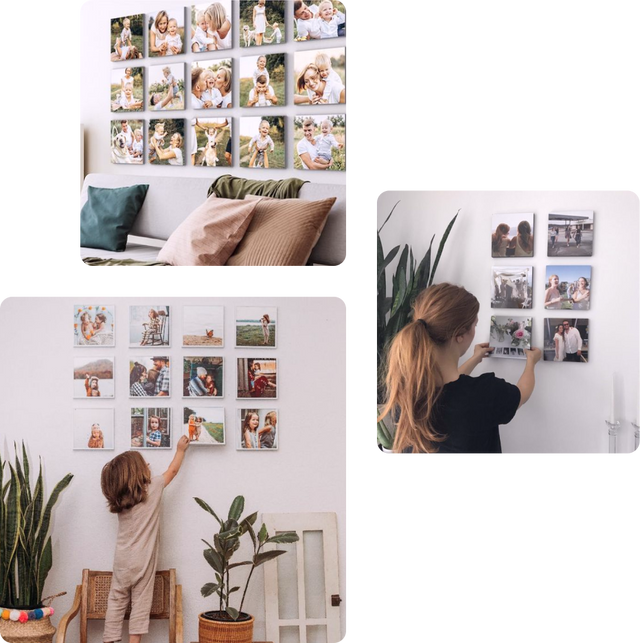







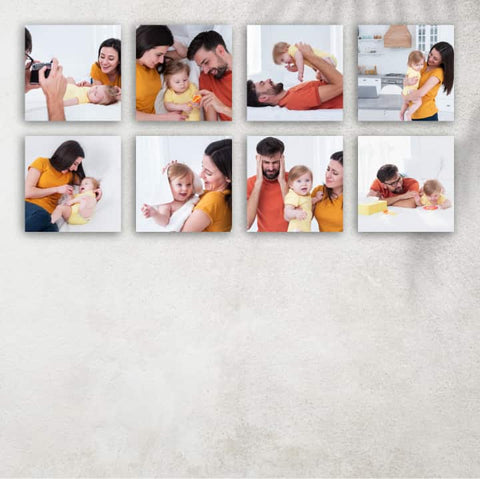
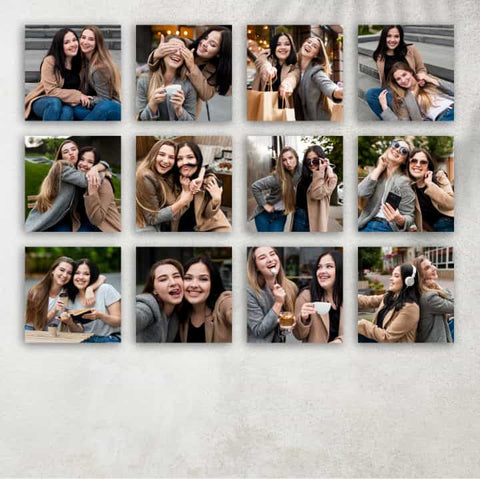


 (4.9/5)
(4.9/5)






